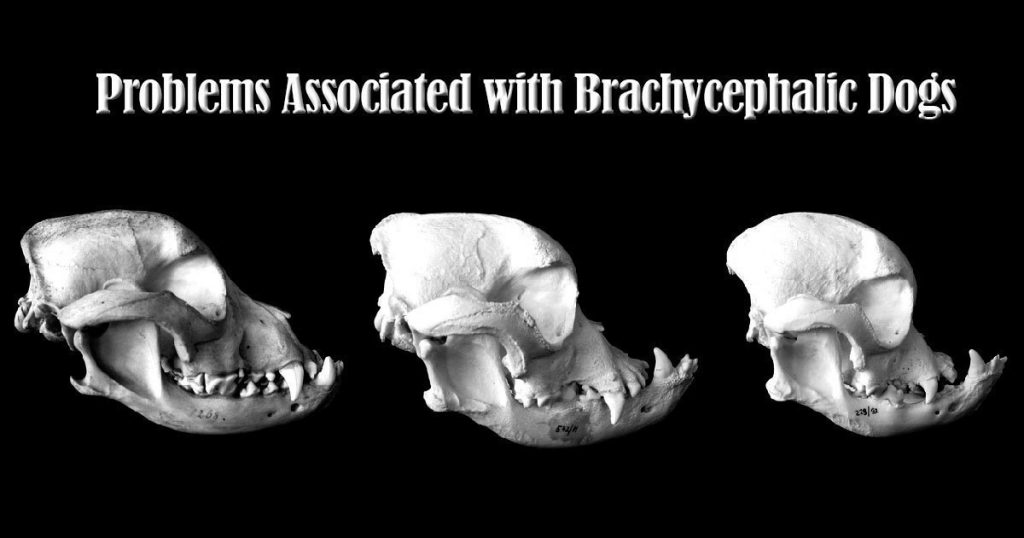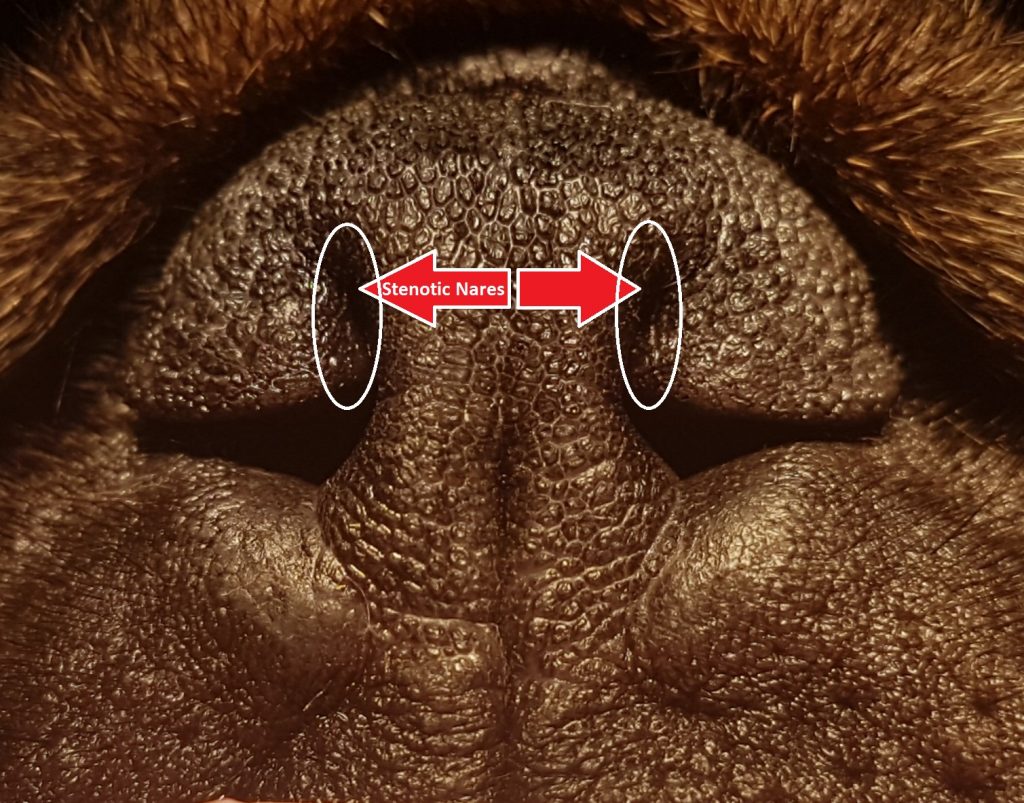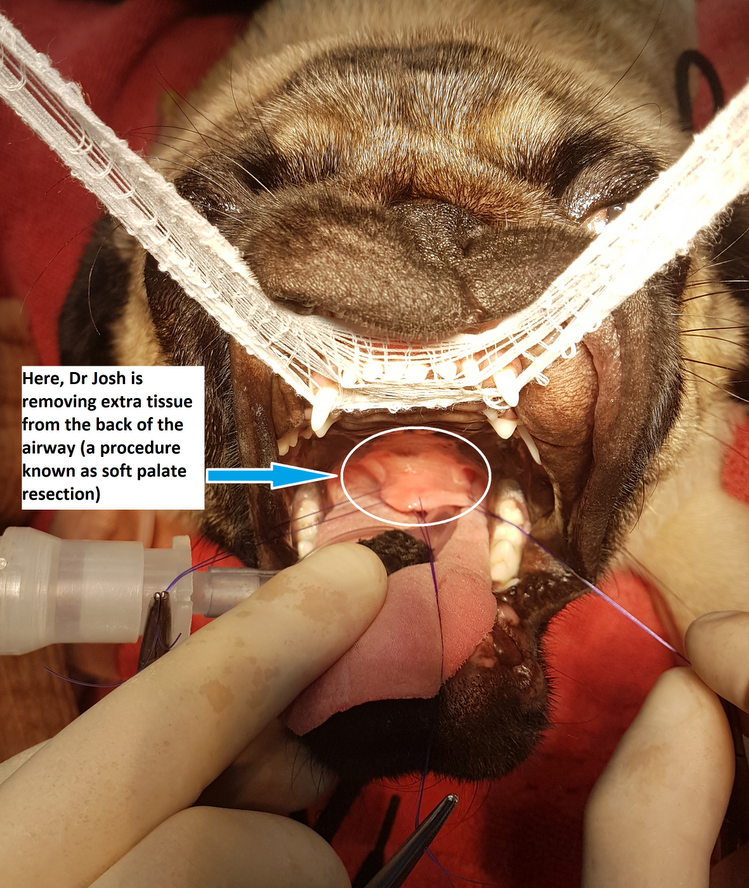This is a blog that we have wanted to share for some time now as it covers a very important topic that we see frequently, but which is often poorly understood. Here at McDowall Vets, we love to see all the playful Puggies and frolicking Frenchies that frequent the practice on a daily basis. Because of this, we wanted to discuss a respiratory problem that is seen and heard all too commonly and shed light on an issue that some of our wonderful owners may not be aware of- Brachycephalic Syndrome.
 So what is this condition and why do you need to know about it? Let’s start by breaking down the terminology. Brachy means short and cephalic means head – we’re talking about all those short headed breeds (think the ones with a squishy nose). This short skull syndrome, although cute, results in the compression of the nasal cavity and airways. By compressing their snout, these individuals often suffer from breathing difficulties. They can’t do anything about it either, it’s just the way they are born. To put a number on it, we would say that 90% of the beautiful brachycephalics we see in the clinic have some level of breathing difficulty. This becomes most apparent during the hotter more humid summer months.
So what is this condition and why do you need to know about it? Let’s start by breaking down the terminology. Brachy means short and cephalic means head – we’re talking about all those short headed breeds (think the ones with a squishy nose). This short skull syndrome, although cute, results in the compression of the nasal cavity and airways. By compressing their snout, these individuals often suffer from breathing difficulties. They can’t do anything about it either, it’s just the way they are born. To put a number on it, we would say that 90% of the beautiful brachycephalics we see in the clinic have some level of breathing difficulty. This becomes most apparent during the hotter more humid summer months.
Luckily there are several things that we can do to greatly improve the quality of lives of our beloved brachy fur family… but we will talk about that later. First, let’s work on understanding the problem better!
Brachycephalic dog breeds include the Pekinese, French bulldog, English bulldog, Shih Tzu, Boston terrier, Japanese Chin and (as if we could forget) the Pug. We love all these breeds for their loyal, fun loving and unique personalities! These dog breeds have proved themselves to be a great addition to families, with popularity for these breeds booming in recent years.
Below you’ll see a picture that depicts the effects of the shortened snout on the skull. Unfortunately there just isn’t enough normal bone structure to support a normal airway.
As a result, there are four components to Brachycephalic Syndrome:
1) Stenotic Nares (small squishy nostrils that result in breathing through a collapsed straw like opening)
2) Elongated Soft Palate (the soft bit of tissue that sits in the back of your mouth as you run your tongue on the roof of your mouth to the back of your throat. This separates the nose from the mouth).
3) Everted laryngeal saccules (abnormal tissue prolapse into the laryngeal opening as a result of the above two problems that will generally occur if left untreated over time).
4) Laryngeal collapse (end stage vocal cord and cartilage collapse that cannot be reversed, usually results in severe breathing complications and could worst-case scenario result in death).
Most dogs suffering from Brachycephalic Syndrome have all 4 of these conditions to a greater or lesser degree. Total laryngeal collapse sounds pretty extreme, but it’s a real concern for brachycephalic dogs who are left untreated long term. Excessive negative pressures during inspiration (breathing in) occur through obstructed nostrils or redundant pharyngeal tissue (elongated soft palate). This directly results in inflammation and increases the risk of further stretching of the redundant soft tissue. As the negative pressure worsens, eversion of the laryngeal saccules and cartilage collapse of the larynx will follow.
Other nasty signs can occur due to the negative sucking pressures associated with the brachys obstructive abnormal breathing pattern. These signs may manifest as tracheal/bronchial collapse and acid reflux in the oesophagus (food pipe). In extreme cases the stomach can also herniate (move into the chest cavity) which is known as a hiatal hernia, and is definitely undesirable!
It is important to remember that the degree of airway obstruction varies with each individual. However, the likelihood of the above consequences (if left unchecked) will increase for both dogs with age, if left untreated.
Early detection is essential. Early correction of the stenotic nares and elongated soft palate greatly increases the chances of success.
 What else can go wrong? It is not unusual during summer for us to see a brachycephalic breed rushed into hospital gasping for air or completely unconscious. It’s a pretty scary emergency for anyone to experience. Many of the times it was simply because they were walked on a hot day and the owners were unaware that there was a breathing problem to begin with. The increased ambient temperature makes it much harder for these brachycephalic animals to breathe normally and could result in slowing down on walks, passing out/collapse and unconsciousness, cyanosis (blue tinge to their mucous membranes due to lack of oxygen) hyperthermia (increased body temperature) and unfortunately, sometimes death.
What else can go wrong? It is not unusual during summer for us to see a brachycephalic breed rushed into hospital gasping for air or completely unconscious. It’s a pretty scary emergency for anyone to experience. Many of the times it was simply because they were walked on a hot day and the owners were unaware that there was a breathing problem to begin with. The increased ambient temperature makes it much harder for these brachycephalic animals to breathe normally and could result in slowing down on walks, passing out/collapse and unconsciousness, cyanosis (blue tinge to their mucous membranes due to lack of oxygen) hyperthermia (increased body temperature) and unfortunately, sometimes death.
Luckily most of the cases we see do not present like this. This is partly because we like to take a proactive approach to avoiding emergency cases like the ones above by identifying affected dogs early and fixing the problem before it become too severe.
The signs to look out for are as follows: Mildly affected dogs will have noisy breathing sounds routinely as well as frequent snoring and snuffling sounds. You may even be hearing these right now as you are reading this blog! Severely affected dogs have a more pronounced airway noise and appear to tire easily with exercise. Other signs may be coughing, gagging, retching and vomiting, often worse with hot/humid weather.
Most dogs are diagnosed with brachycephalic syndrome between 6 months and 4 years of age. We routinely check all of our susceptible patients while they are under anaesthetic at 6 months of age being desexed. Both males and females appear equally affected.
So what can you do about it?
Give us a call, please! We love to help and find it hugely rewarding to be able to help these dogs and go on to watch their lives transform. They go on to exercise better, become more playful, have better weight control and live longer! Who wouldn’t want that! Dr Josh has a special interest in airway surgery and is extremely competent at these procedures, so please book a consultation with him to discuss your options. Josh can confirm if your pet is suffering from brachycephalic syndrome, and discuss treatment/surgical correction options.
One of the main reasons for writing this blog is that we are seeing more and more patients who have had partial surgeries performed elsewhere which have not solved their problems. Some vets are unable to perform the soft palate resection aspects of the surgery and so are just widening the nostrils and not addressing the bigger issues present in the back of the dog’s throats. This will not give your pet the desired result and we have found that we are having to go on to perform corrective surgery on a number of patients where this has happened.
What could these treatment options be?
The key to correcting this set of problems is early intervention. As most of the issues are present in the back of the throat we normally need to anaethetise these patients to assess the extent of soft palate elongation and laryngeal saccule evertion.
Dogs with only mild or intermittent signs and mild elongation of their soft palates can often be managed without surgery by controlling their exercise levels, avoiding hot or humid conditions, keeping them in air-conditioned areas during the summer, and avoiding stress.
Dogs with the severe breathing signs and significant elongation of their soft palate, will always benefit from surgery. Dr Josh has performed numerous soft palate and nares modification surgeries and as a team we are very accomplished with the pre and post anaesthetic care required for these patients. An example of the procedure can be seen in the link below:
https://www.qldvetspecialists.com.au/brachycephalic-airway-syndrome
Severely affected dogs (those requiring surgical airway corrections) should not be bred from to try and improve the long term genetics of the breed. Breeding selection has directly contributed to this problem. While we’re not saying that all breeders are to blame we can help avoid passing the severely affected genes on to future offspring through responsible breeding. For this reason, severely affected animals are often desexed at the same time of the surgical airway correction, if safe to do so in the same procedure. Alternatively, two separate procedures may be indicated by Dr Josh.
Above photo: The white ovals depict stenotic nares (squished, collapsed nostrils). This makes air intake to the lungs much harder. As if you were trying to breathe through a straw.
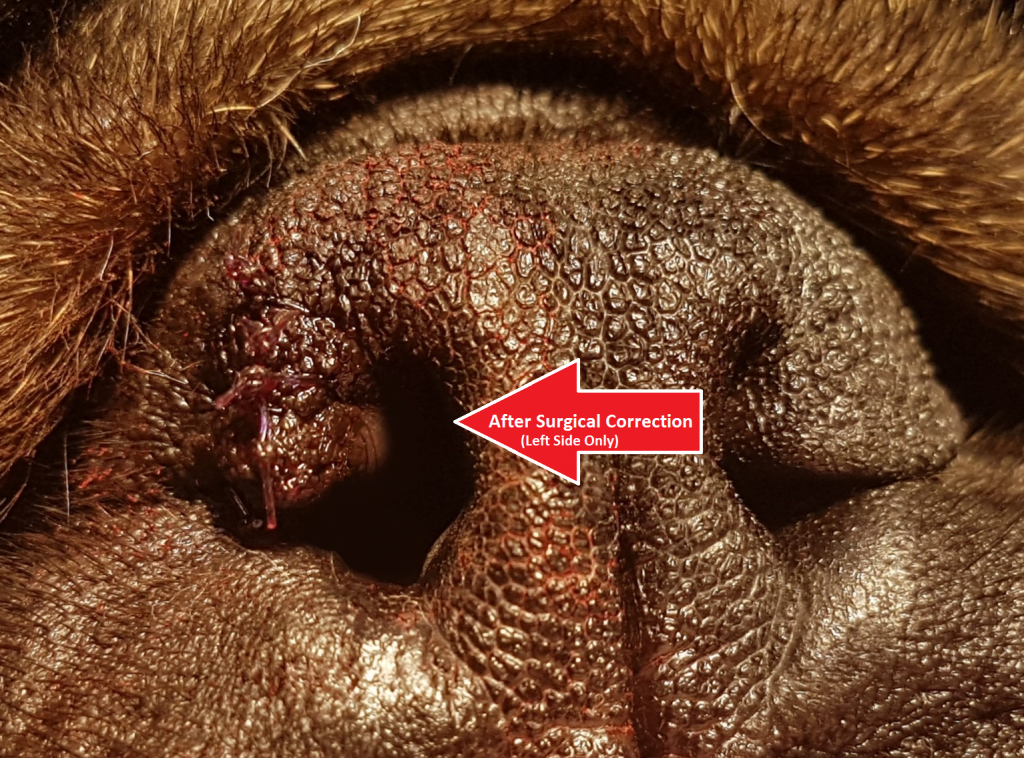 Above photo: The picture above shows the halfway point of stenotic nares surgery. One surgically corrected nostril is seen on the left side and the right nostril is yet to be corrected. Note the difference in how much more air this pug can breathe-in with adequate correction.
Above photo: The picture above shows the halfway point of stenotic nares surgery. One surgically corrected nostril is seen on the left side and the right nostril is yet to be corrected. Note the difference in how much more air this pug can breathe-in with adequate correction.
Above photo: This picture shows a Pug with an elongated soft palate (excessive redundant tissue) that is located in the back of the throat. This elongated soft palate was falling into the poor Puggie’s airway and causing obstructive breathing. The length of the soft palate can only be assessed under general anaesthesia.
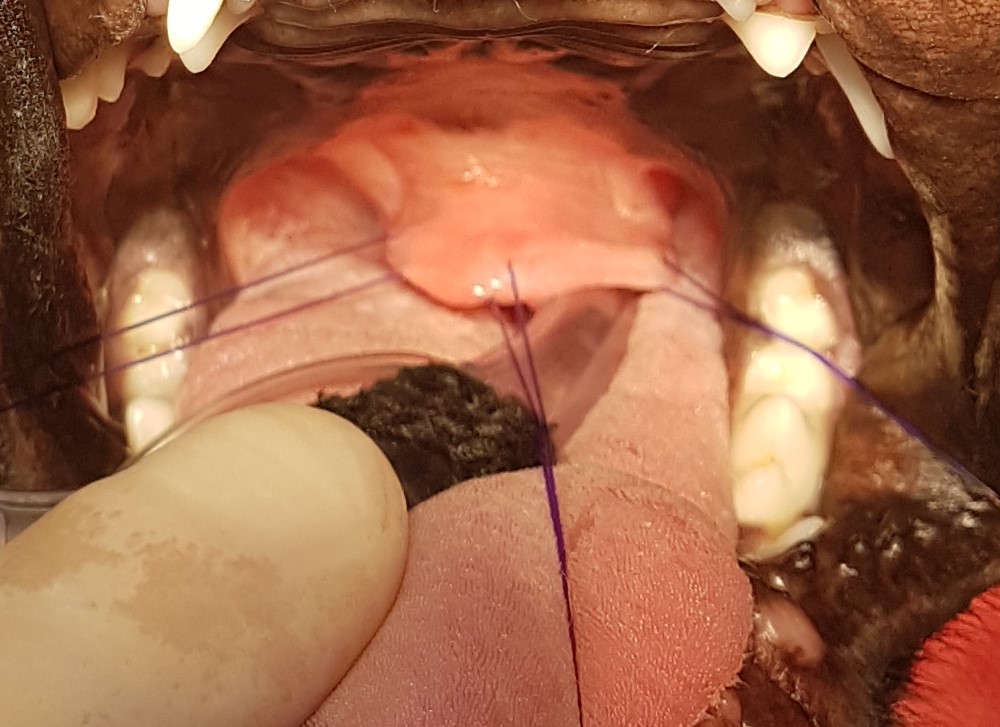 Above photo: Close-up view of an elongated soft palate.
Above photo: Close-up view of an elongated soft palate.
Above photo: The elongated soft palate is trimmed to the level of the tonsils and tip of the epiglottis (the food trap-door in the back of the throat). This procedure is called a Staphylectomy.
 Above photo: Close-up view of a surgically corrected elongated soft palate. The Larynx is now visible where the red arrow is pointing. The anaesthetic tube entering into the Larynx is visible and the excessive elongated soft palate is no longer obstructing the airway.
Above photo: Close-up view of a surgically corrected elongated soft palate. The Larynx is now visible where the red arrow is pointing. The anaesthetic tube entering into the Larynx is visible and the excessive elongated soft palate is no longer obstructing the airway.
Other than surgical correction, there are some additional measures you can put into place to help your brachycephalic dog. Obesity will dramatically worsen the brachycephalic syndrome signs, and it is important to maintain a healthy body weight as prevention and part of a normal healthy condition. Chest harnesses should be used also to prevent tugging on the neck and avoid further compression on the airways.
We hope that this has been informative and has helped to clarify this common and debilitating condition that many of our pets suffer from. If you are concerned, we would love to help – give us a call on 3353 6999.

